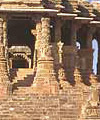|
Wildlife
[ Velavadar (Black-Buck Sanctuary) | Pania
Wild Life Sanctuary | Narayan Sarovar Sanctuary
| Jambu Ghoda Wildlife Sanctuary | Ratan
Mahal Sloth Bear Sanctuary | Shoolpaneshwar Wild
Life Sanctuary | Jessore Sloth Bear Sanctuary
| Balaram Ambaji Wild Life Sanctuary | Hingolgadh
Nature Education Sanctuary | Rampara Wild Life
Sanctuary | Khijadia Bird Sanctuary | Gaga
Wildlife Sanctuary | Marine National Park
| Kutch Bustard Santuary | Barda
Wildlife Sanctuary | Porbandar Birds Sanctuary
| Vansda National Park | Purna Wild
Life Sanctuary | Nal Sarovar Bird Sanctuary
| Wild Ass Sanctuary | Gir Wildlife
Sanctuary ]
Velavadar
(Black-Buck Sanctuary)
The main attraction of the park located seventy-two km away from
the city of Bhavnagar is the massive population of Black Buck, Antelope,
Wolf and other endangered species of birds. Thirty-nine species
of grasses and 46 species of sedges, shrubs and trees represent
the diversity of flora. The fauna of the park comprises mainly of
Black buck, Antelope, Blue bull, wolf, jackal, hyena, jungle cat,
fox, Wild Boars and birds as well. The exclusive Indian Black buck,
which the sanctuary is named after, is one of the most graceful
and beautiful animals of its kind. Endangered birds like Houbara
Bustard, Lesser Florican, Sarus White Storks, White Pelican, Montagu,
Pallid Harriers, Marsh and other raptors including the Greater Spotted
Eagle, juvenile Imperial Eagle, Bonelli's Eagle, Short-toed Snake
Eagle and Long-legged Buzzard are also seen in the park. During
the rainy season the breeding of Lesser Florican is seen largely
in the park. Sarus cranes also regularly breed in the park during
the monsoon season. This place has earned popularity as the largest
roosting ground for four species of migratory harriers in the entire
world.
Top
Pania
Wild Life Sanctuary
The Sanctuary has been established especially to protect the Chinkara.
Gir Sanctuary constitutes boundary in south and east of this prime
habitat of Chinkara. The lions freely move around the foothills
in this area. The hilly and undulating tract renders the area suitability
for Chinkara and with a view to emphasising conservation of this
small antelope, the area has been declared as a separate sanctuary.
Amongst the fauna of this area lion, leopard, hyena, wildcat, civet
cat, spotted deer, chinkara, bluebull, wild boar, four-homed antelope,
pangolin, python, peafowl, porcupine, desert cat and fox are the
major species. During the census of 1995, 5 lions, 134 spotted deer,
75 individuals of nilgai, 6 individuals of four-homed antelope,
19 individuals of chinkara and 2 wild boars were counted in this
area.
Top
Narayan
Sarovar Sanctuary
Narayan Sarovar Sanctuary is a unique area in the country. It supports
15 threatened species of wildlife belonging to Schedule-I of the
Wildlife (Protection) Act, 1972. Some of the species of semi-desert
habitat, which are recorded in this region, are not common in other
areas in the country. Scrub and desert thorn forest interspersed
with numerous seasonal water-bodies and grassy patches provide an
ideal habitat for chinkara, caracal, ratel, wolf, desert cat, desert
fox, great Indian bustard, lesser florican and a variety of waterfowl.
'Gorad' and 'Babul' are predominant plant species. 'Babul' is found
extensively in the western zone with lime stone formation, whereas
'Gorad' is main species in the eastern zone, which covers extensive
area.
Top
Jambu
Ghoda Wildlife Sanctuary
This is one of the good forest areas in Chhota Udepur division.
It is also an important area for nature education and environmental
awareness camps. The forest plays important ecological and hydrological
roles of constituting catchments of small rivers, preventing soil
erosion and maintaining health of the watershed. It also plays socio-economic
role by satisfying basic needs of tribal communities living in and
around the Sanctuary. Local tribal people collect minor forest produce
from the area for their livelihood.
Top
Ratan
Mahal Sloth Bear Sanctuary
About 55.65 sq. km area of the Sanctuary is a triangular landmass,
which covers reserve forests of 11 villages. The entire area of
the forest not only has high aesthetic, educational and scientific
research values, but also maintains climatic and environmental stability
of the region. It maintains health of watersheds and catchments
of Panam and Orsang rivers. Sloth bear, Hyena, Jackal, Chausinga,
Civet cat, J. Cat are the main species found here.
Top
Shoolpaneshwar
Wild Life Sanctuary
Sloth bear, Leopard, Rhesus macaque Chausinga, Barking deer are
the main species. The forests are some of the best and the densest
in the State and are known for richness of bio-diversity. The sightings
of various bird species, which have more affinities with Himalayan
and Western Ghat, have unfolded a hitherto unknown, but interesting
aspect of the area. Moist deciduous forests have very high scenic
and aesthetic values. Moist teak forest, moist mixed deciduous forest,
Dry deciduous scrub, Dry bamboo brakes and Dry tropical riverine
forest, constitute varied habitats in the Sanctuary.
Top
Jessore
Sloth Bear Sanctuary
Jessore Sloth Bear Wildlife Sanctuary has a hilly and rugged terrain,
which is a home to a large number of endangered species. Jessore
Sloth Bear Wildlife Sanctuary, Gujarat, India, in a way also plays
an important role in the sustenance of the green zone beyond the
Desert region of Rajasthan, India. Jessore is a safe haven for the
Sloth Bear, which is an animal greatly popular with the tourists
and the adventure seeking travelers who come to visit Jessore Sloth
Bear Wildlife Sanctuary, situated in Gujarat, India. Sloth bear,
leopard, sambar, blue bull, wildboar, porcupine and variety of birds
are found here.
Top
Balaram
Ambaji Wild Life Sanctuary
Situated in the picturesque Aravali hill series in the northern
most part of Gujarat, along Gujarat-Rajasthan border, Balaram-Ambaji
Wild life Sanctuary is a treasure house of rare medicinal herbs
and shrubs together with rare and endangered species of wild life.
Sloth bear, Leopard, Hyena, Wolf, Nilgai, Jungle cat, Indian hare
are the main species here. The floral constituents of the sanctuary
are classified into Southern Dry Mixed Deciduous and Desert Thorn
forests.
Top
Hingolgadh
Nature Education Sanctuary
The Sanctuary is situated in Jasdan taluka of Rajkot district. Acacia
senegal dominates the Vegetation of the forest. The sparse woody
vegetation at places has given way to profuse growth of grass, which
is the main contributor of fodder for the herbivorous animals like
Chinkara and Nilgai. 'Kasedo' and 'Sishoti' are the dominant shrubs
having edible fruits and they attract variety of birds. The forest
area has tremendous ecological impact on the surrounding villages.
As per remote sensing study carried out by GEER Foundation, the
vegetation cover increased in the Sanctuary in 1996 and 1998.
Top
Rampara
Wild Life Sanctuary
The Government in 1975 acquired the area of the sanctuary. The area
is an important forest for the preservation of over 280 species
of plants, over 130 species of birds, over 20 species of mammals,
over 20 species of reptiles and several species of amphibians and
invertebrates. It is also an important site of natural beauty with
hills, plains, grasslands and forest area. In short, the Sanctuary
has adequate ecological, faunal, geomorphologic, zoological, natural
and aesthetic significance.
Top
Khijadia
Bird Sanctuary
This bird sanctuary is located 10 kms from Jamnagar.The Sanctuary
is located in the western-most part of the country and falls on
the traditional route of the migratory birds. Consequently, the
Sanctuary supports a variety of migratory birds including the waterfowl.
This is an extremely important staging and wintering area for a
wide variety of waterfowl. Almost 200 species of birds are recorded
in the Sanctuary, including over 90 species of waterfowl. It is
the known breeding ground of the Great Crested Grebe, which otherwise
is migratory and uncommon in the State. As stated earlier, Khijadia
is a seasonal wetland adjoining coastal wetland. Dense cover of
Prosopis chilensis in a portion of the lake provides shelter to
some mammals and nesting sites for some birds.
Top
Gaga
Wildlife Sanctuary
The Gaga Great Indian Bustard Sanctuary is situated on the coast
of the Gulf of Kuchh, where the high tidal zone constitutes the
boundary in the north. The area has derived a high conservation
value due to the rare sightings of the endangered Great Indian Bustard
in the saline grassland of this area. Besides the bustard, the Sanctuary
also supports different terrestrial birds and some wild mammals
like wolf and jackal. The area comprises of grasslands intermixed
with saline scrubs. Prosopis scrubland, saline grassland and high
tidal zone are the major features of this protected habitat.
Top
Marine
National Park
Gujarat has the distinction of creating the country's first Marine
National Park in the Gulf of Kutch, 30 km. from Jamnagar. Here corals
create fantasies in stone and are the master builders of the Park.
Their limestone fortresses - those found near the Pirotan Islands
and the rich moist deciduous forests like those found in the dense
forests of the Danes. One of the most threatened birds, the great
Indian bustard finds a refuge in certain pockets of protected areas.
The world's only four-horned antelope, the chowsingha is found here
in healthy numbers. One of the largest herds of blackjacks grace
the grasslands of Velavadar and till recently Gujarat was the place
where flamingos nested in huge numbers.
Dugong, a marine mammal, which resembles a seal, along with the
rare Borolo species, have found home in the protected areas of the
Marine National Park. Here one will find plants that look like animals
and animals that look like plants. Turtles, shrimp, sponge, eels,
sea urchin lurk among the corals and huge schools of fish create
a brilliance of colors that are unknown, unseen and unimaginable
to us. There are fishes, which puff-up when threatened octopuses
that mimic the color and texture of the surroundings in the blink
of an eyelid so as to vanish without a trace.
Top
Kutch
Bustard Santuary
This is a small area of just 2 sq. km, pulsating with avifaunal
and mammalian life of the grassland habitat. The area is ideal for
those wanting to see Great Indian Bustard in Gujarat. Kuchh Bustard
Sanctuary provides food and shelter to an endangered bird of the
Indian subcontinent-the Great Indian Bustard. The species like lesser
florican, chinkara and wolf. Black Partridge ('Kalo Tetar') is seen
very frequently, which enhances the joy of birding. It may be noted
that Black Partridge is seen only in limited areas of the state.
The Sanctuary is also a good place to see raptors like harriers
and eagles and migratory birds like Houbara Bustard and Common Crane.
Top
Barda
Wildlife Sanctuary
The forest is endowed with very rich floral composition and it was
also a home of Asiatic lion in not a distant past. Kileshwar, a
temple and camping site developed by 'Jamsaheb' of Jamnagar, is
a beautiful site in the heart of the forest. Among mammals ratel,
leopard and wolf are threatened species. Amongst the reptiles found
here, crocodile and chameleon are rare and endangered. Of the four
common venomous snakes, three are found here. At least two species
of birds, which were found in the Sanctuary, are rare/ endangered.
They are Spotted Eagle and Crested Hawk-Eagle. Apart from this,
the Sanctuary exhibits great variety of invertebrate species including
variety of butterflies. Lion, Chinkara, Sambar and Spotted Deer
found in the recent past, are now exterminated from Barda. Although
the area of Sanctuary is small, it has different types of forests.
Top
Porbandar
Birds Sanctuary
This is the smallest bird Sanctuary of Gujarat, which is established
amidst the city. It provides the practical example of co-existence
of man and nature. The area supports good population of Flamingos
and other resident and migratory waterfowl. In the past, flamingos
had attempted nesting also. The Sanctuary covers the fresh Water
Lake, which receives considerable waters from the city's gutters.
Top
Vansda
National Park
Even though the park is small, it is extremely dense and has a wide
variety of flora and fauna. Some parts of the park are dark even
during daytime. The forest is a habitat to Leopards, python, four-horned
antelope, pangolin, rusty-spotted cats, Jungle Cat, Civets, Mongooses,
Macaques, Barking Deer, giant squirrels, Hyenas and a wide species
of birds. Birds like the Great Black Woodpecker, Malabar Trogon,
Shama and Emerald Dove, Grey Hornbill, Racket-Tailed Drongo, Paradise
Flycatcher, Leaf birds, Thrushes, Sunbirds, peafowls etc. are found
here.
Small creatures with their amazing diversity are the real treasure
of the park. Among these are over 60 species of butterflies and
121 species of spiders. The largest of the spiders of Gujarat, the
Giant wood spider is common here and around 30 species of snakes
are found here. Besides, there are numerous varieties of insects,
centipedes, millipedes and snails as well as about 11 types of frogs
and toads.
Top
Purna
Wild Life Sanctuary
Purna is a Sanctuary, where luxuriant dense forests with thick bamboo
brakes enchant visitors. Wild bulls, elephants, Sloth bear and rhinoceros
also roamed in this forest-tract during historic past (Mughal Period).
Forests of this region satisfy material and cultural needs of local
tribals and maintain ecological stability of the area.
Top
Nal
Sarovar Bird Sanctuary
The lake - Nalsarovar - and the wetlands around it were declared
a bird sanctuary in 1969. Spread over 120 sq.kms, the lake and the
extensive reed beds and marshes are an ideal habitat for aquatic
plants and animals. The lake attracts a large variety of birds like
plovers, sandpipers and stints. A black tailed, small, brown and
white wader with a slightly up curved bill, the bird travels 3500
kms from its nesting ground in Central Europe to spend the winter
at Nalsarovar in Gujarat. More than 200 types of birds migrate here
to escape the harsh winter of their nesting areas. These migrant
birds visit Nalsarovar every year from November to February. During
these four months water is plentiful and fish, insects and aquatic
plants abound in the lake - an ideal environment for the birds.
When food and water are scarce in Nalsarovar, some resident birds
go away for short periods to nearby areas and return to the lake
after monsoon to a feast of fish and insects.
There are 360-odd islets in the lake. Most of them lie exposed
when the water level is low. The migratory birds arrive in vast
numbers, homing in on the lake. Flocks of pelicans, flamingoes,
ducks, demoiselle cranes, common cranes, and several waders occupying
huge patches of the lake during the season is a beautiful site.
The migratory birds and most of the resident birds, such as cormorants,
grebes and open bill storks, begin to leave by April.
Top
Wild
Ass Sanctuary
Wild Ass is locally known as 'Ghud Khar'. It was once common in
the Northwestern India, West Pakistan and South Iran. They are now
found only in the Rann of Kachchh of Gujarat State. The Wild Ass
belongs to the Family Equide, which includes Horses, Zibras and
Donkeys.
Top
Gir
Wildlife Sanctuary
Sprawling in an area of 1424 sq. kms, Gir with its dry deciduous
forest is a luxuriantly rich ecosystem-endowed with floral and faunal
plentitude. Thirty species of mammals, twenty species of reptiles,
several species of insects and birds are found here. The forest
is the only place in the world, outside Africa, where the lion can
be seen in its natural habitat. Gir, the last refuge of the king
of the jungle, is one of the largest and most important wildlife
sanctuaries in India.The number of lions in Gir had dwindled to
a mere 15 by the turn of the century, due to extensive trophy hunting.
Top
Information on wildlife tours, wildlife viewing, wildlife park and
nature of Wildlife of Gujarat - India"
|







